Amd Radeon Pro Wx 7100 W/8gb Gddr5 Review
Radeon Pro WX7100 – With quantum pricing and a single slot form gene, AMD is helping break down the barriers to VR with its new high-end workstation GPU.
Consumer Virtual Reality headsets, powerful Graphics Processing Units (GPUs) and new generation 'CAD to VR' software are all doing their bit to make VR a key applied science for design, technology, manufacturing, compages and construction. But, in order for VR to get mainstream, and go a fixture on the desks of designers, engineers and architects where information technology can truly influence the design procedure, the price of workstation GPU hardware needs to fall.
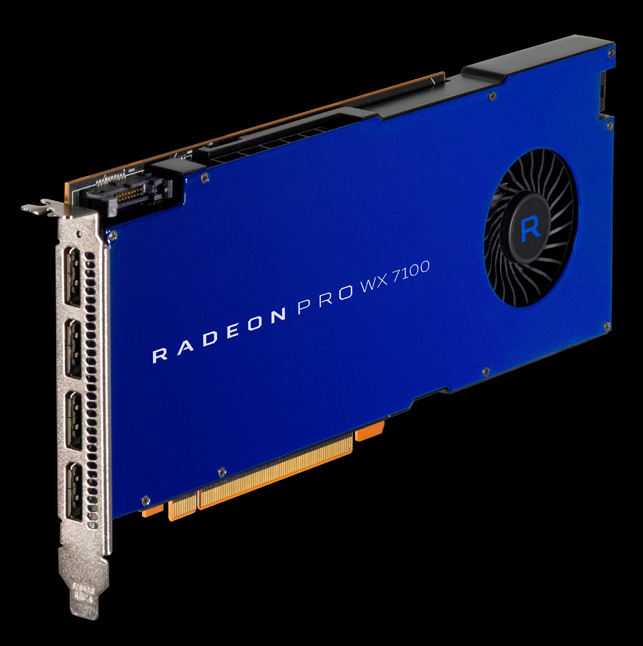
Forking out $2,000 for a workstation-class 'VR Set up' GPU is hard to swallow when y'all are used to paying a fraction of that for one capable of accelerating 3D CAD.
But costs are already starting to come downward. This month AMD shipped the offset always workstation 'VR Gear up' GPU for under $1,000. At $799 (£649), the AMD Radeon Pro WX7100 (8GB) is around a 3rd of the toll of Nvidia'south cheapest workstation GPUs for VR, the Quadro M5000 (8GB) and the brand new Quadro P5000 (16GB).
With the AMD Radeon Pro WX7100 it is now possible to get a VR capable professional person CAD workstation for just over $2,000, and that even includes the Oculus Rift or HTC Vive VR head mounted brandish (HMD).
Radeon Pro WX
Regular readers of DEVELOP3D will be familiar with AMD FirePro, but this summer AMD decided to call time on its long standing professional person graphics brand. The ruddy and black FirePro Due west Series is now being replaced with the blue Radeon Pro WX Series – the thought being that AMD volition do good from the strong brand recognition that Radeon has in the consumer games sector.
To all intents and purposes, Radeon Pro WX is merely an development of AMD FirePro. Information technology benefits from years of FirePro driver development and includes optimisations for a massive range of CAD (and other 3D) tools. Withal, there are as well some subtle differences. For one, AMD is keen to point out the superior build quality of this new GPU, including more robust heat sinks and a PCB with thicker 'gold fingers' for a better (and more durable) connectedness to the PCI slot.
Also, in a professional graphics beginning, AMD backs this up with a x-year warranty (standard three-yr and extended vii-twelvemonth upon registration). x years is certainly re-assuring, but with VR and graphics developing at such a stride, cards like the WX7100 are likely to become obsolete long before they surrender the ghost.
Radeon Pro WX7100 – Certification
Like AMD FirePro earlier it, AMD Radeon Pro WX volition be optimised, tested and certified for all the major CAD applications. Certification – and the assurance that GPUs will perform speedily and reliably when using professional person 3D applications – is particularly important for enterprises. Starting with driver optimisations, the AMD Radeon Pro WX7100 will then get through this process.
While certification for CAD is long established, certification for VR is not. Ane would question whether AMD would ever certify the Radeon Pro WX7100 for VR 'game engines' such every bit Unreal and Unity. However, in that location are many specialist CAD VR applications in development, and AMD has said that it is working with multiple developers, citing Autodesk Stingray as one instance.
AMD also emphasises that the Radeon Pro WX7100 is for content creation too every bit VR consumption, and therefore users need a certified GPU that is also able to run CAD. This is not just for operation and stability just to get access to specialist features such as SolidWorks RealView and Order Independent Transparency. OIT improves performance when displaying transparent objects in a number of CAD tools including PTC Creo and SolidWorks.
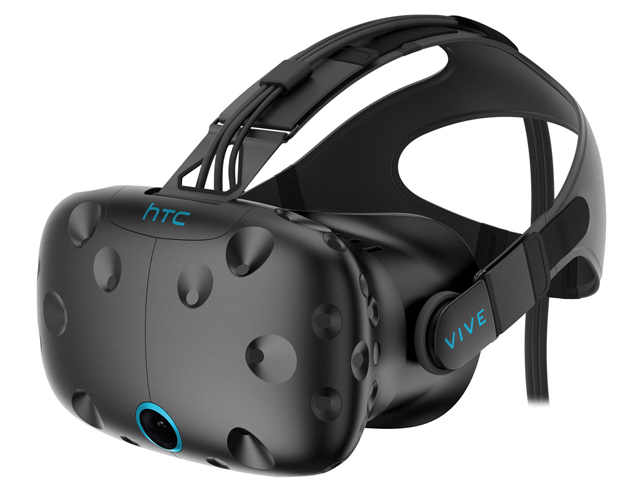
HTC Vive Business concern Edition – ideal partner for the AMD Radeon Pro WX7100
The AMD Radeon Pro WX7100
In addition to being the least expensive workstation GPU for VR, the AMD Radeon Pro WX 7100 is also the smallest. Designed for a single PCIe slot it can fit into workstations that the double slot Quadro M5000 and Quadro P5000 cannot. This includes popular CAD-focused mini tower workstations like the Dell Precision 3620 and HP Z240. For those looking to upgrade their current 3D CAD workstation and make it capable of running VR this could exist particularly relevant.
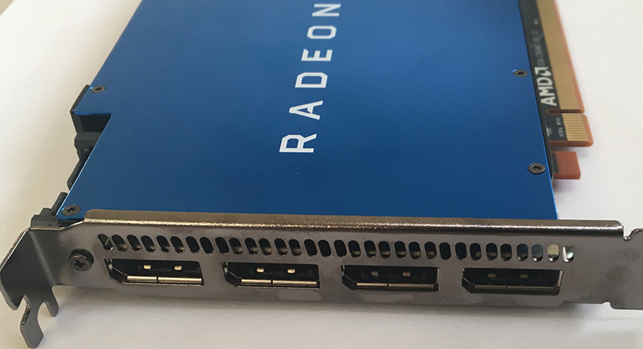
The single slot GPU has iv DisplayPort i.iv outputs.
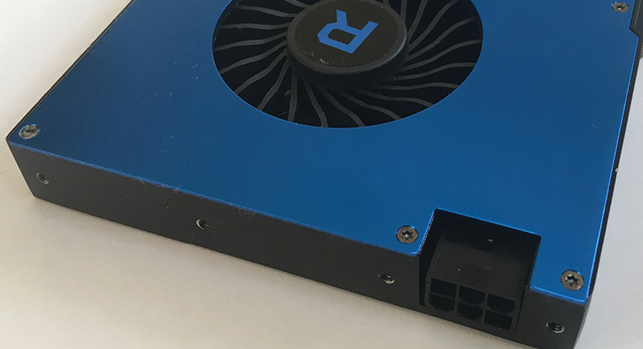
Rated at less than 130W, the Radeon Pro WX7100 merely needs one auxiliary six-pin power connector
Single slot also means lower power consumption. The Radeon Pro WX7100 is rated at less than 130W and only needs one auxiliary 6-pin power connector, which comes direct from the workstation's Power Supply Unit (PSU).
Acme single precision performance is a whopping 5.seven TFLOPs. This is virtually double that of its predecessor, the AMD FirePro W7100 (3.3 TFLOPs) and even greater than the AMD FirePro W9100 (5.24 TFLOPS), AMD's previous generation flagship professional GPU which draws 275W at elevation.
This huge leap in performance/watt is down to a new power efficient 14nm manufacturing process developed for AMD's 'Polaris' 4th gen Graphics Core Adjacent (GCN) architecture. Smaller transistors mean less power is needed for the betoken to motion between them.
In terms of spec, the bill of fare features 8GB of GDDR5 memory, which should be plenty for mainstream VR workflows, and four DisplayPort 1.4 ports. Importantly, 2 Radeon Pro WX7100 GPUs tin can be used in tandem using AMD CrossFire Pro technology. In theory, this could increase operation significantly, though support and the level of boosted performance will depend on applications.
Radeon Pro WX7100 – Testing for VR
To run 3D CAD on a second display, your GPU needs to exist capable of rendering 30 Frames Per Second (FPS) or more. Some users even find 10-15 FPS to be adequate, although dropping below this can make it difficult to accurately position models on screen.
In dissimilarity, for a adept VR experience on the HTC Vive or Oculus Rift, you need 90 FPS or more. Crucially, your GPU must not drop below that magic number. If it does, you may experience sick or, worse still, be sick.
At DEVELOP3D we usually like to test GPUs in a workstation with a 4.0GHz+ CPU. That way the CPU has less chance of becoming the workstation'south bottleneck, giving the GPU the headroom information technology needs to show its true potential.
Withal, at the time of testing, our workstation options were limited, then we had to put the AMD Radeon Pro WX7100 through its paces in a Dell Precision Tower 5810 with a 3.2GHz Intel Xeon E5-1680 v3 CPU. This CPU is pretty much the borderline recommended spec for the Oculus Rift and HTC Vive. With a faster CPU we would look all of the benchmark scores to become up.
For comparison, nosotros tested with iv other GPUs: the Quadro M4000 (8GB), which is the equivalent single slot sub $ane,000 GPU from Nvidia (but is not considered VR Gear up); the double slot 'VR Ready' Nvidia Quadro M5000 (8GB), which has merely been replaced by the Quadro P5000 (16GB); and two previous generation professional GPUs, the AMD FirePro W7100 (8GB) and FirePro W8100 (8GB). Unfortunately, as the Nvidia Quadro P5000 is so new, we were non able to become our easily on one in fourth dimension for these tests. However, we would expect there to be a pregnant improvement over the Quadro M5000.
Benchmarking for VR is still in its infancy, but there are currently two key tests: the SteamVR Performance Test and Futuremark's VRMark. Both benchmarks are designed primarily to show if your PC is capable of running VR (earlier you make your VR headset purchase) then they are typically run on a standard brandish.
While both benchmarks are skewed towards 3D gaming, they should give a pretty proficient indication as to how your workstation might perform in a game engine VR experience. The aforementioned might not be true of engineering grade VR applications like IC.IDO from ESI Group, which tend to place a bigger emphasis on detailed geometry than centre candy textures.
The Steam VR Performance Test is quite bones, in that it only gives an overall 'fidelity' score to inform you lot whether or not your organization is capable of running VR content at 90 FPS. To exist considered 'VR Fix' y'all need a score of 6.0 or above, so with 6.iii, the Radeon Pro WX7100 simply only passed. Information technology was some way behind the Nvidia Quadro M5000 (7.two). All the other GPUs were way off the pace.
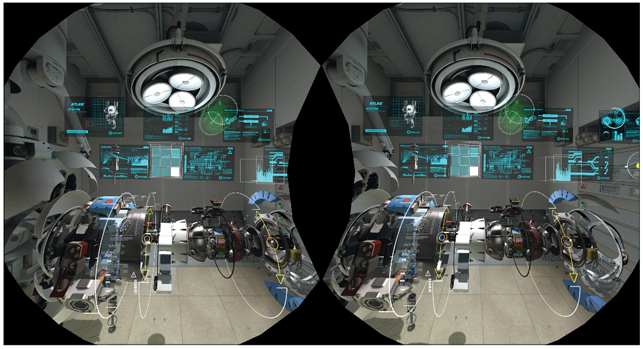
SteamVR Functioning Examination
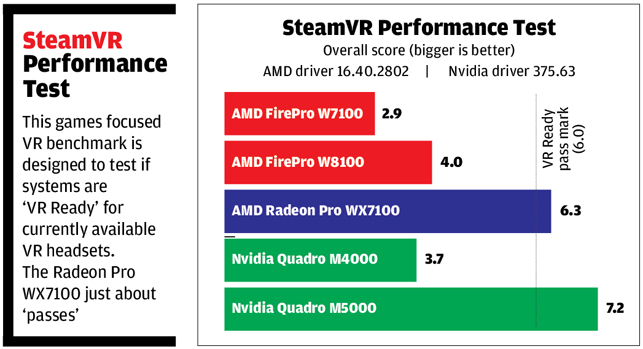
VRMark presents a much more than straightforward score in FPS. To pass, your workstation has to maintain a consequent frame rate of 109 FPS or above without dropping frames. This is college than the best-selling minimum 90 FPS for VR as the benchmark needs to make some adjustments when information technology is running on a desktop display.
VRMark has two tests. The 'Orange Room' is designed to test readiness for current VR headsets and renders at 2,264 × 1,348 resolution (1,132 10 1,348 per centre). This is slightly higher than the native display resolution of the HTC Vive and the Oculus Rift (1,080 × 1,200 per eye) and is due to distortion correction.
The 'Blue Room' is all about future generation HMDs and renders an even more circuitous scene at a breathtaking 5,012 × 2,880 (5K) resolution. To read more about the benchmark, and to download the test to see how your electric current workstation compares, visit futuremark.com/benchmarks/vrmark.

The Orange Room criterion
focuses on geometry processing, illumination and GPU imitation particles

In the 'Orange Room', the AMD Radeon Pro WX7100 maintained an impressive 133 FPS, just a touch off the 141 FPS delivered with the Quadro M5000. As expected, none of the other GPUs passed the exam.
A quick run through the highly taxing 'Blueish Room' showed just how much graphics technology needs to better earlier information technology is capable of driving side by side generation VR headsets. The AMD Radeon Pro WX7100 and Nvidia Quadro M5000 put in scores of 22.5 FPS and 25.2 FPS respectively, way off the target 107 FPS. As of Oct 2016, Futuremark says that no publicly available commercial arrangement is able to laissez passer this test.
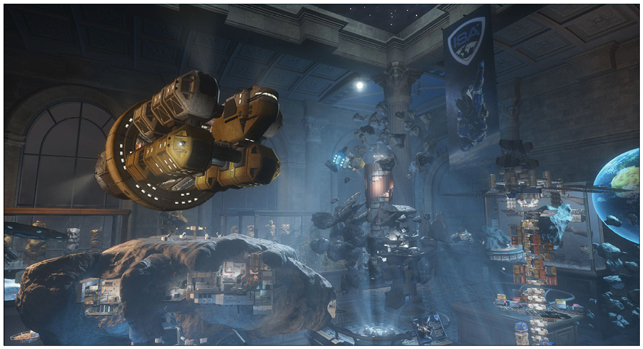
VRMark 'Blueish Room' renders at an incredible v,012 × 2,880 (5K) resolution to simulate future VR headsets
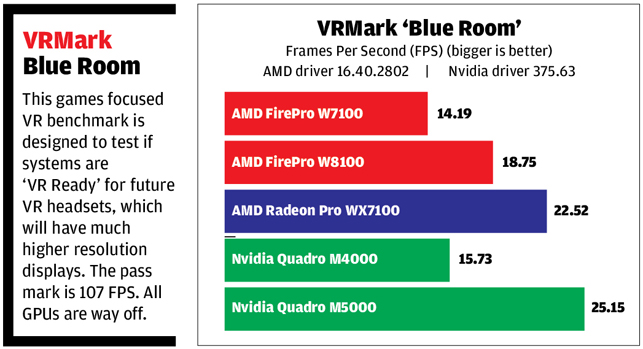
Still useful constructed benchmarks may be, in that location is no substitute for real earth testing with your own VR datasets. This is something that nosotros hope to explore more side by side year.
In the meantime, our limited experience of using an AMD Radeon Pro WX7100 with an HTC Vive has been positive. Using an HP Z840 workstation with Intel Xeon E5-2687 v4 (3.0GHz) CPUs, navigation effectually a luxury flat using a VR environment adult by VROOM was very smooth.
Radeon Pro WX7100 – Beyond VR
While the AMD Radeon Pro WX7100 is 'VR capable', it doesn't mean yous have to apply it for VR. The high-end GPU is also well suited to traditional design visualisation in applications like Autodesk 3ds Max and Autodesk VRED. We tested the GPU with a couple of existent world automotive datasets.
In Autodesk 3ds Max 2017, we ramped up all the lighting, shadows and anti-aliasing settings on a 9 one thousand thousand polygon automotive model. We rotated the model in a consistent way using a 3DConnexion SpaceMouse and captured the frame rate with a utility chosen FRAPS. As with the VR tests, the Radeon ProRender WX7100 came second to the Quadro M5000 (42 FPS versus l FPS), merely there was a significant comeback over the previous generation AMD FirePro W7100 and W8100.
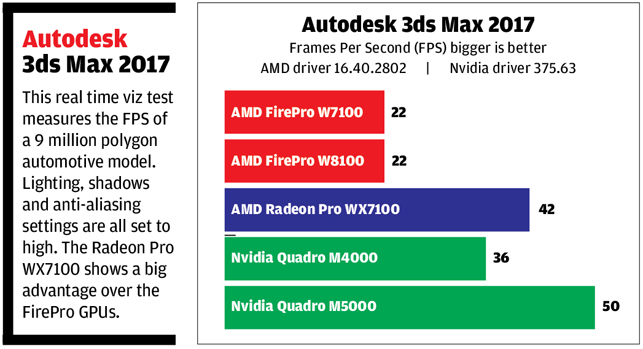
We followed a like test process with Autodesk VRED Professional person 2017. With anti-aliasing disabled the Quadro M5000 was just under 25% faster than the AMD Radeon Pro WX7100. However, when the anti-aliasing settings were ramped up to ultra-high, the Radeon Pro WX 7100 actually developed a small atomic number 82.
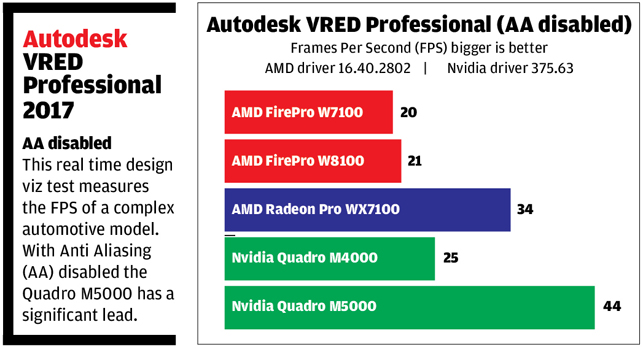

3D CAD (SolidWorks)
We had a few hiccups when testing with SolidWorks 2015, insofar as our SPECapc for SolidWorks criterion crashed during most runs. AMD told u.s. that this was downwards to a known outcome with the Radeon Pro sixteen.40 driver and anti-aliasing in SolidWorks, which will be remedied shortly with a new driver.
However frustrating this might be, information technology is re-assuring to know that Radeon Pro WX commuter bug like this are identified and fixed. It highlights the importance of choosing a GPU that is certified for your CAD applications of choice. If this type of issue happened with a consumer GPU information technology would unlikely be fixed.
To get an thought of the kind of performance 1 might look in SolidWorks we followed the same testing procedure with FRAPS and the SpaceMouse. We chose the computer assembly model, one of many from the SolidWorks 2015 SPECapc criterion.
The results showed that performance was CPU express (meaning the CPU was the bottleneck rather than the GPU). As a event, all 3 AMD GPUs delivered very similar scores, even with the GPU-hungry RealView and Ambience Occlusion effects turned on. Both Nvidia cards as well showed identical results, but delivered frame rates approximately 30% faster than AMD.
With a faster CPU (or a different CAD model) we may have seen some variation between each family of GPUs. Nonetheless, this pattern of performance is quite typical when using higher-end cards to run 3D CAD.
In short, it shows that if you lot only want to run 3D CAD, and then the Radeon Pro WX7100 is probably overkill.
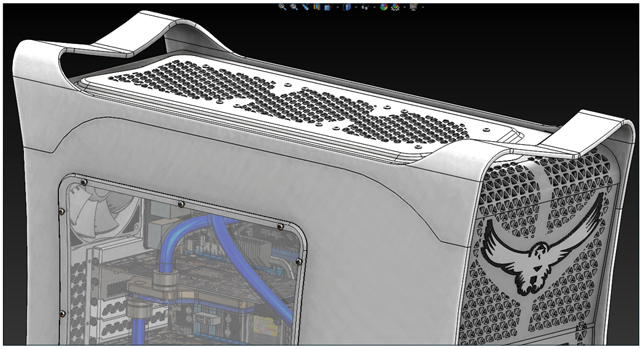
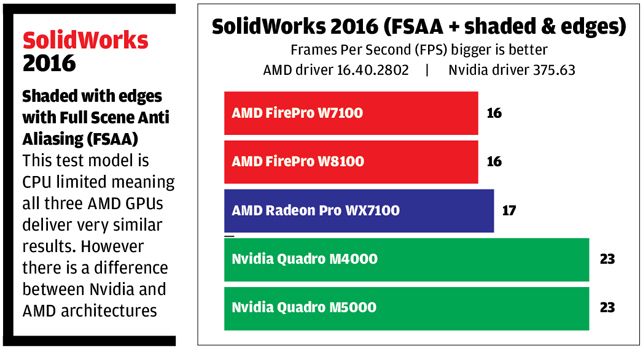
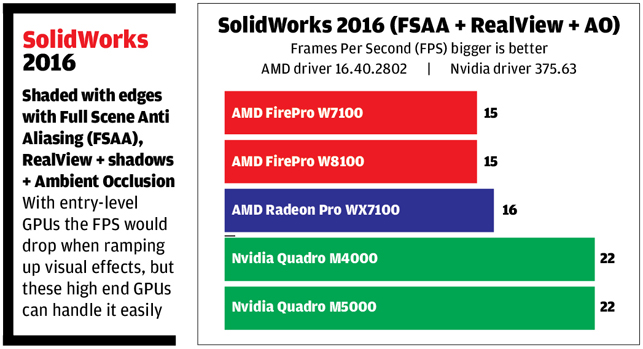
******************* 22/xi/sixteen UPDATE *************************
AMD provided us with a point release xvi.40.2802.1005 driver, which fixed the SolidWorks issue.
We tested with the SPECapc for SolidWorks 2015 benchmark, which aggregates the performance of 13 different models. While all iii AMD GPUs delivered similar scores with RealView, shadows and Ambient Occlusion enabled, in shaded and edges mode the AMD Radeon Pro WX7100 was around 13% slower than the AMD FirePro GPUs.
Nosotros'd expect the AMD Radeon Pro WX7100'due south SolidWorks functioning to improve with subsequent commuter releases, merely it would probably still evidence that at that place is lilliputian need for a card of this class if you only want to run 3D CAD. The same would probably exist truthful for most CAD software.
******************* 22/11/16 UPDATE *************************
Physically-based rendering
The AMD Radeon Pro WX7100 isn't just about interactive 3D graphics on a desktop display or in VR. It tin besides be used for number crunching.
AMD Radeon ProRender is a new physically-based renderer that simulates how lite reflects off and refracts through objects. The software is complimentary and is available for Rhinoceros, SolidWorks, 3ds Max and Maya, although some of these plug-ins are still in beta. AMD Radeon ProRender will also be bachelor for Cinema4D next year.
Physically based rendering is very computationally intensive. Virtually renderers utilize CPUs to practice the calculations but this AMD-developed software tool is optimised for AMD GPUs (although it too runs on Nvidia GPUs and CPUs).
For testing we used the digger assembly from the SolidWorks 2015 SPECapc benchmark and rendered at 1,280 x 720 resolution using highest quality settings.
There was a notable divergence between the three AMD cards, with relative functioning aligned closely to the rated TFLOPs of each card.
We also ran the test on Nvidia GPUs, by and large out of marvel to come across how they would perform. Equally Nvidia does not optimise its GPUs for Radeon ProRender (it has its own GPU renderer chosen Iray) you should not read too much into these results.
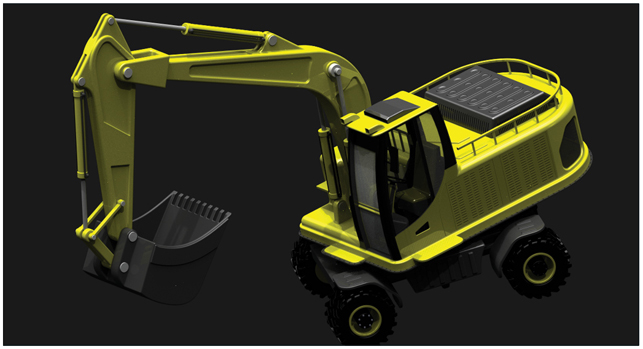
Digger model taken from the SPECapc for SolidWorks 2015 benchmark
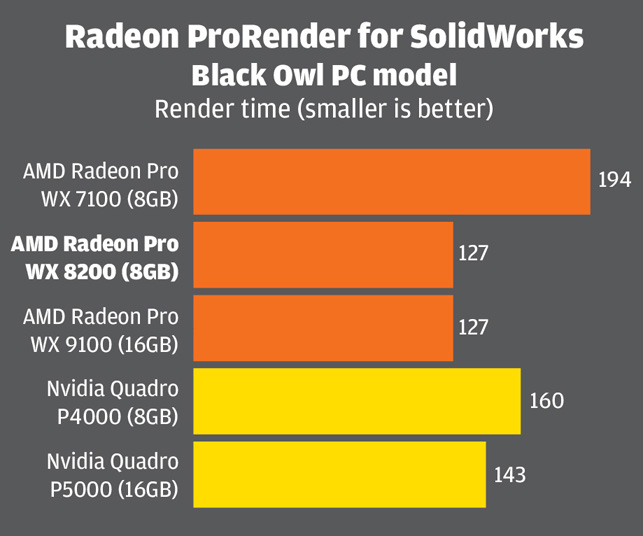
Conclusion
The AMD Radeon Pro WX7100 is a very powerful workstation-class GPU. It not but delivers industry leading price/performance but does and then in a single slot form factor, meaning information technology tin can be used in virtually all CAD workstation towers.
When it comes to workstation VR, information technology's in a class of its own, significantly lowering the price of entry. Nvidia does not currently accept a single slot 'VR Ready' workstation GPU and all of its dual slot 'VR Ready' GPUs price considerably more.
So what practise you get for your $799? While the GPU is clearly 'VR Ready', our benchmarks show that VR performance is quite entry-level, even though scores will probable increase with subsequent driver releases and when using a college GHz CPU.
In practise we await information technology to exist well suited to 'game engine' VR experiences (presuming geometry, textures and other parts of the scene are sufficiently optimised). But when running more demanding VR applications, such equally ESI Grouping'south IC.IDO, when dataset complexity increases, or when graphical detailing is ramped upwards, it may kickoff to struggle – think entire buildings (rather than select rooms), huge manufacturing production lines, detailed automotive engineering models, or when VR scenes are rendered with high-levels of anti-aliasing.
Of course, AMD certainly has plans for loftier-end workstation VR GPUs and next year we await to see the company introduce more than powerful models with more on lath retentivity. If history is anything to become, there volition exist 2 dual slot additions to the Radeon Pro WX Series – the Radeon Pro WX8100 and Radeon Pro WX9100.
The other workstation GPU to wait out for is the AMD Radeon Pro SSG, which AMD previewed this summertime. With an on-board 1TB Solid State Drive (SSD) continued directly to the GPU's retentivity, this new type of GPU promises to dramatically cutting data load times. Information technology could pave the way for dynamic new applications in VR using gigantic datasets.
At the same time, Nvidia is expected to innovate a 'VR Ready' GPU to compete with the Radon Pro WX7100 on price and form cistron. This will most likely exist a single slot GPU called the Quadro P4000 and be a replacement for the Quadro M4000. In brusk, there volition be plenty more professional person VR options to suit dissimilar budgets and requirements. This can simply be good news for end users.
Finally, while the AMD Radeon Pro WX7100 is being pitched as a price conscious workstation GPU for VR, it is important to re-iterate that it does not accept to be used for VR. From design viz to physically-based rendering in that location are plenty of other CAD-centric workflows that will benefit from this powerful, sub $ane,000, GPU.
Nosotros wait to meet the GPU adopted by Tier One workstation manufacturers next year. UK-manufacturer Armari is also developing a low cost, small form factor VR workstation based around the AMD Radeon Pro WX7100 and other VR capable GPUs.
Related manufactures:
Source: https://develop3d.com/reviews/radeon-wx7100-cad-viz-vr-workstation-solidworks-3dsmax-vred-steam-vrmark/
0 Response to "Amd Radeon Pro Wx 7100 W/8gb Gddr5 Review"
Post a Comment